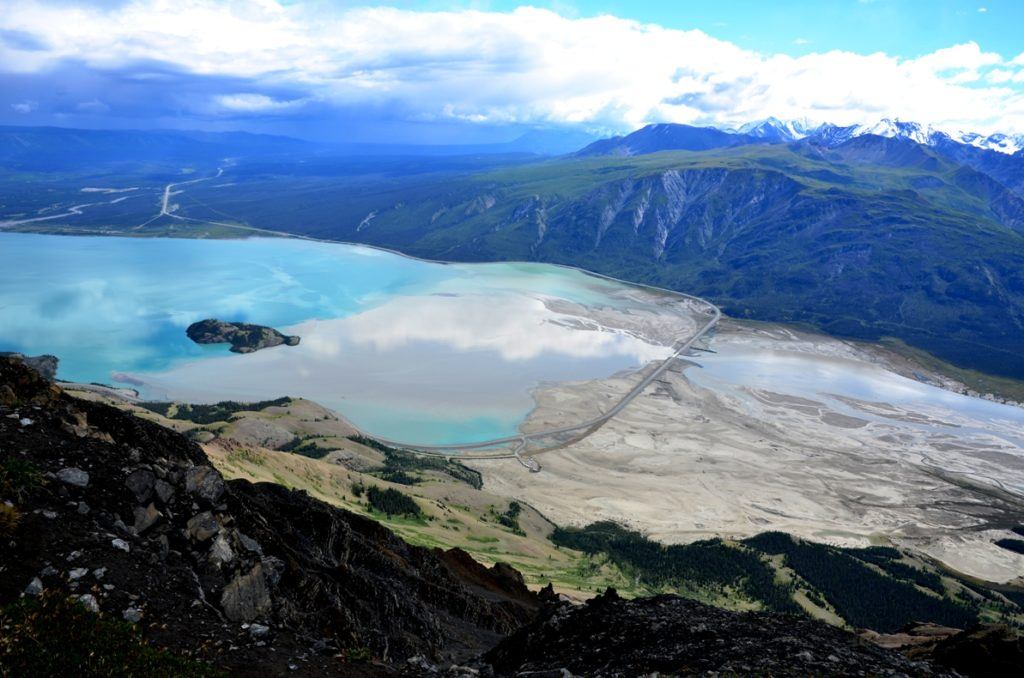Scientists in Canada have recorded a change in the flow of a major river due to climate change

Recently, a group of scientists from Canada published the results of a study of a large river in the circumpolar region of Canada. Experts believe that they have encountered the first case of a change in the direction of the flow of a large river due to anthropogenic climate changes. This is not about human activity as a whole, because in its history various states have changed currents or have completely dried up various rivers and larger reservoirs (let us remember the Aral Sea). Now they talk about the specific manifestation of climate change in the form of melting glaciers.
In mid-2016, Canadian scientists realized that in one of the Yukon regions belonging to Canada, water from the glacier began to flow instead of one river system into another. Because of this, the river, which previously flowed into the largest lake of Yukon Clouane , became shallow, and most of the glacier meltwater now flows down another river to the Pacific Ocean in southern Alaska.
Researchers claim that such changes occurred for the first time in the history of mankind. Of course, before the river changed the course and direction of flow, but the reasons were natural, for the most part they were geological in nature. Now the anthropogenic influence is becoming more noticeable.
')
“The river did not become where we were just a few years ago. That is, the river has remained, but this is only a pale shadow of what it was, ”said Daniel Sugar, head of the research group from the University of Washington at Tacoma. He says that the flow of the river has changed due to the fact that the glacier that feeds it has changed: "In fact, we see every day how the water level falls, we see shallows appearing."
The results of the study were published in the authoritative scientific publication Nature Geoscience. Scientists from six Canadian and American universities took part in the work.
According to scientists, the level of Lake Cwayne also began to fall, and very noticeably. Of course, this was to be expected, since the disappeared river was one of the largest water “arteries” feeding the lake. But the rates of shoaling surprised specialists. The lowest water level in Cloughne was recorded in August. People living in this region are now forced to follow the water, leaving the usual places. So far this concerns only two small communities, but this is only the beginning.
“The water level in Cloughne has already fallen and continues to fall. If the dynamics continue, the lake will turn into a closed reservoir, which will change the chemistry of the water, the structure of the lake itself and the biological component, ”the researchers report in their article.
Changes did not happen suddenly. Last year, the waters of the retreating glacier broke through the ice barrier, resulting in a glacier lake that previously fed the Sliems River, which is referred to. The mass of water broke into the system of another river, leaving a noticeable channel through which the water began to go in the other direction. Previously, all these waters flowed into the vast Yukon River.

The figure clearly shows the new channel, which opened the way for water to another region. Because of this, the waters that previously fed the Slims River went into a different river system.
Scientists believe that there is only one reason that the water is gone - a gradual climate change, which led to the melting of glaciers. This process began in 1956 and continues to this day.
The second river, where the water from the glacier began to fall, is called Alsek. It flows into the Gulf of Alaska , where a large mass of fresh river water is now being noted.
As mentioned above, all these changes have not yet had a great impact on people, who are few in the region. But if the same situation occurred in another, more densely populated area, then the changes could change the lives of people and very much. Such changes can be observed elsewhere on Earth. For example, in the Bolivian Andes, where people living in lowlands are in danger of being flooded with glacial waters that have broken through from above. The reason is the same - warming.

The Kaskoolsh glacier is close to the polar circle, so it can be called indicative in terms of its ability to track climate change. Its total area is 25,000 kilometers. Now scientists are actively observing the region, trying to predict further changes.
As for the river Slims, then, according to experts, it will not disappear completely. Rather, it will move into a new state of equilibrium and will continue to exist. “This is an interesting study that confirms climate change and gives insight into the scale of what is happening,” said glaciologist Richard Ellie of Penn State University.
Source: https://habr.com/ru/post/373381/
All Articles